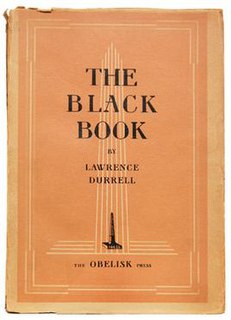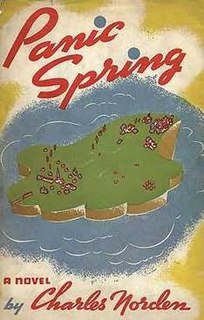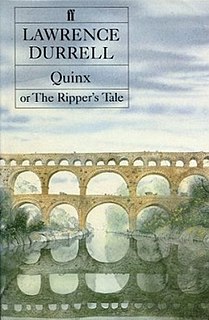 W
WThe Alexandria Quartet is a tetralogy of novels by British writer Lawrence Durrell, published between 1957 and 1960. A critical and commercial success, the first three books present three perspectives on a single set of events and characters in Alexandria, Egypt, before and during the Second World War. The fourth book is set six years later.
 W
WBalthazar, published in 1958, is the second volume in The Alexandria Quartet series by British author Lawrence Durrell. Set in Alexandria, Egypt around World War II, the four novels tell essentially the same story from different points of view and come to a conclusion in Clea. Balthazar is the first novel in the series that presents a competing narrator, Balthazar, who writes back to the narrating Darley in his "great interlinear."
 W
WThe Black Book is a novel by Lawrence Durrell, published in 1938 by the Obelisk Press.
 W
WClea, published in 1960, is the fourth volume in The Alexandria Quartet series by British author Lawrence Durrell. Set in Alexandria, Egypt, around World War II, the first three volumes tell the same story from different points of view, and Clea relates subsequent events.
 W
WConstance, or Solitary Practices (1982) is the central volume of the five novels of Lawrence Durrell's The Avignon Quintet, published from 1974 to 1985. It was nominated for the Booker Prize in 1982. Involving some of the characters from the preceding Livia, the novel also introduces new ones. It is set before and during World War II, in France, Egypt, Poland and Switzerland.
 W
WJustine, published in 1957, is the first volume in Lawrence Durrell's literary tetralogy, The Alexandria Quartet. The first in the tetralogy, Justine is one of four interlocking novels, each of which tells various aspects of a complex story of passion and deception from differing points of view. The quartet is set in the Egyptian city of Alexandria in the 1930s and 1940s, the city or Alexandria itself as described by Durrell becoming as much of a complex character as the human protagonists of the novels. Since first becoming available to the public and reviewers in 1957, Justine has inspired what has been called "an almost religious devotion among readers and critics alike." It was adapted into the film of the same name in 1969.
 W
WLivia, or Buried Alive (1978), is the second volume in British author Lawrence Durrell's The Avignon Quintet, published from 1974 to 1985. Durrell has described the novels as "roped together like climbers on a rockface, but all independent. .. a series of books through which the same characters move for all the world as if to illustrate the notion of reincarnation." The first novel of the quincunx, Monsieur, received the James Tait Black Memorial Prize in 1974.
 W
WMonsieur, or The Prince of Darkness (1974), is the first volume in Lawrence Durrell's The Avignon Quintet. Published from 1974 to 1985, this sequence of five interrelated novels explore the lives of a group of Europeans before, during, and after World War II. Durrell uses many of the experimental techniques of metafiction that he had integrated into his Alexandria Quartet, published 1957 to 1960. He described the later quintet as a quincunx.
 W
WMountolive, published in 1958, is the third volume in The Alexandria Quartet series by British author Lawrence Durrell. Set in Alexandria, Egypt, around World War II, the four novels tell essentially the same story from different points of view and come to a conclusion in Clea. Mountolive is the only third person narrative in the series, and it is also the most overtly political.
 W
WThe Revolt of Aphrodite consists of two novels by British writer Lawrence Durrell, published in 1968 and 1970. The individual volumes, Tunc and Nunquam, were less successful than his earlier The Alexandria Quartet, in part because they deviate significantly from his earlier style and because they approach more openly political and ideological problems.
 W
WPanic Spring is a novel by Lawrence Durrell, published in 1937 by Faber and Faber in Britain and Covici-Friede in the United States under the pseudonym Charles Norden. It is set on a fictional Greek Island, Mavrodaphne, in the Ionian Sea somewhere between Patras, Kephalonia, and Ithaca. The island, however, resembles Corfu strongly, and in at least one inscribed copy of the novel, Durrell includes a map of Corfu identified as Mavrodaphne.
 W
WPied Piper of Lovers, published in 1935, is Lawrence Durrell's first novel. It is followed by Panic Spring, which partly continues the actions of its characters. The novel is in large part autobiographical and focuses on the protagonist's childhood in India and maturation in London.
 W
WQuinx, or The Ripper's Tale (1985), is the 5th and final volume in Lawrence Durrell's "quincunx" of novels, The Avignon Quintet, published from 1974 to 1985. It explores the activities of Constance, Aubrey Blanford, Robin Sutcliffe, Lord Galen, and most of the other surviving characters as they return to Avignon and Provence in the immediate aftermath of World War II.
 W
WThe Revolt of Aphrodite consists of two novels by British writer Lawrence Durrell, published in 1968 and 1970. The individual volumes, Tunc and Nunquam, were less successful than his earlier The Alexandria Quartet, in part because they deviate significantly from his earlier style and because they approach more openly political and ideological problems.
 W
WSebastian, or Ruling Passions (1982), is the fourth volume in The Avignon Quintet series by British author Lawrence Durrell, which was published from 1974 to 1985. This novel is set mainly in Switzerland immediately after World War II. It continues the story of Constance and a Gnostic cult, which was introduced in the first novel of the quintet, Monsieur (1974).